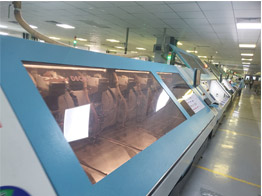
What is the Cause of Poor Tin on the PCB Board?
As a PCB Fabrication Company Manufacturer, share with you the reasons for poor soldering. The circuit board may not be well tinned during SMT production of SMT. Generally, the poor tinning is related to the cleanliness of the Prototype PCB surface. There is basically no bad tinning if there is no dirt. Second, when tinning Poor flux, temperature, etc. So what are the main manifestations of common tin defects in circuit board production and processing? How to solve this problem?
1. There are particulate impurities on the plating surface of the board, or abrasive particles are left on the circuit surface during the manufacturing process of the substrate.
2. The surface of the board is covered with grease, impurities and other impurities, or there is residual silicone oil
3. There are flakes on the surface of the board that are not tinned, and there are particulate impurities on the surface of the plate.
4. The high-potential coating is rough, and there is a phenomenon of burning the board.
5. The tin surface of the substrate or part is oxidized and the copper surface is dull.
6. On one side, the plating is complete, and on the other side, the plating is not good, and there are obvious bright edges at the low potential holes.
7. Low-potential holes have obvious bright edges, high-potential coatings are rough, and board burning is a phenomenon.
8. Insufficient temperature or time is guaranteed during soldering or the flux is not used properly
9. Low potential large area can not be tinned, the surface of the board is slightly dark red or red, one side of the plating is complete, the other side of the plating is poor.
Improving and preventing the electrical tin of PCB board:
1. Periodic laboratory analysis of potion ingredients, timely addition, increase current density and prolong plating time.
2. Check the anode consumption from time to time to supplement the anode.
3. Hexel groove analysis to adjust the content of brightener.
4. Reasonably adjust the distribution of the anode, reduce the current density properly, rationally design the board wiring or patchwork, and adjust the lightening agent.
5. Strengthen the pre-plating treatment.
6. Reduce the current density and regularly perform maintenance or weak electrolytic treatment on the filtration system.
7. Strictly control the storage time and environmental conditions of the storage process, and strictly operate the production process.
8. Use a solvent to clean the sundries. If it is silicone oil, you need to use a special cleaning solvent for scrubbing.
9. Control the temperature of the PCB soldering process at 55-80 ℃ and ensure sufficient warm-up time
10. Use flux properly.
Our company also has Aluminum Clad Circuit Board on sale, welcome to consult.
Previous: Is It Related To The Phone Data Cable When The Phone Is Charging?
Next: 4K P2.5 Indoor Rental LED Screen with Die-casting Aluminium Cabinet
Copyright:@2020-2021
Comments Please sign in or sign up to post.
0
0 of 500 characters used